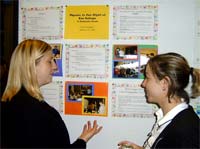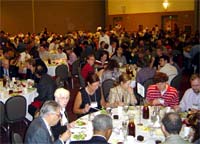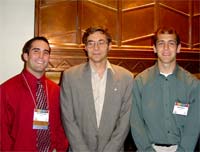| <
back to congress reports
< photo albums
 |
|
Sara
Campbell (left) was one of four Coe College undergraduates
that presented posters during the 2004 Sigma Pi Sigma
Congress.
|
|
Having
founded the Coe College chapter of Sigma Pi Sigma in the
spring of 2004, we at Coe were very excited to send students
and faculty to what is arguably the society’s most
sparkling event. We had seven students and three faculty
in all representing our chapter, which included Dr. Steve
Feller, the current president of Sigma Pi Sigma and Sara
Campbell, the Associate Councilor for Zone 11. Our students
presented four posters during the poster sessions, the subject
of three of them being past student research and one on
our annual outreach program of hosting physics demonstrations
for elementary schoolchildren at our college.
The
Congress also included several plenary sessions spread throughout
the two-day event. The topics ranged from Nobel Prize winning
research to Einstein’s greatest discoveries to ethics
facing today’s scientists. The speakers with their
respective lecture titles included: Jocelyn Bell Burnell
“Pulsars and Extreme Physics,” John Rigden “Einstein,
1905, 1999: Legacy and Hope,” John Marburger “Science
Ethics: A Governmental Perspective,” Dwight Neuenschwander
“Taking the Ethics of Einstein into the 21st Century,”
Carl Wieman “Bose-Einstein Condensation,” and
Worth Seagondollar “The First Man-Made Nuclear Explosion.”
With each speaker being so well known in his/her respective
field, it was amazing to listen to each person’s experiences
and first hand knowledge.
Jocelyn
Bell Burnell’s presentation titled “Pulsars
and Extreme Physics” stunned the crowd of undergraduates,
professors, and alumni with facts about the evolution of
stars and incredible details of a neutron star.
Einstein
and the World Year of Physics in 2005 were discussed in
two other presentations. Einstein’s feat of publishing
five pioneering papers within a timeframe of less than six
months and the ethical issues that he had to deal with were
explained.
|
|
|
Sigma
Pi Sigma congress participants voted on proposals
which were a result of the four ethics workshops.
|
Another
set of sessions dealt with ethics in physics and allowed
Sigma Pi Sigma members to vote on several proposed resolutions
at the conclusion of four workshops. The workshops dealt
with topics such as: career choices, research integrity,
diversity in the scientific field, and tenure for faculty
members. Each workshop began with the presentation of case
study, was turned over to the attendees to discuss in small
groups, and then finally discussed as a large group. We
arrived to consensus by gathering comments from the small
groups to form proposals, and then voted on these proposals
on in the final day of the Congress. Each proposal that
was approved was then sent to the SPS council for fine-tuning
to discuss the adoption of these proposals as new society
resolutions.
John
Marburger, the science advisor to the President of the United
States, spoke during dinner on Friday evening. His topic,
governmental ethics, interested many in the crowd, and he
was able to answer a few questions at the conclusion of
his speech.
Carl
Wieman, a Nobel Laureate, discussed his award winning research
on the topic of Bose-Einstein Condensation (BEC). Although
his research is very complex, Wieman talked about it in
a manner that was easy to understand by all in attendance,
even to undergraduates who had never been previously exposed
to the topic. We were also privilaged to spend some time
talking one on one with Dr. Wieman following his presentation
(more on this below).
 |
|
Society
members enjoyed formal banquets with prominent speakers
on both Friday and Saturday night. |
|
The
Congress concluded with a speech by past Sigma Pi Sigma
president Dr. Worth Seagondollar, in which he shared personal
recollections of his experience with the world’s first
atomic explosion at the Trinity Site in the New Mexico desert
nearly 60 years ago. His incredible memories of the event
held the crowd in suspense as he told stories of dropping
radioactive spheres, avoiding snakes, collaborating with
world-famous physicists, and the actual moment of witnessing
the bomb’s detonation. His speech capped off the night
and was a perfect conclusion to the 2004 Congress.
Now
back to Dr. Wieman. In addition to giving those of us in
attendance a fascinating lecture on BEC, Nobel Laureate
Carl Wieman showed that not only is he impressive as a talented
scientist but also as a man willing to share his knowledge
with others. At the conclusion of his presentation, he entertained
questions and comments from those interested to speak with
him for as long as anyone was left. Following this, Dr.
Wieman sat down with Kit and I for what we thought would
be a brief interview. We had the extreme pleasure to speak
with him for over thirty minutes. His passion for science
and learning was abounding. Despite his superior intellect,
we were impressed to find out that he was humble, approachable,
and easy to understand.
|
| |
Dr.
Carl Wieman (far right) shows a picture from his 2001
Nobel Prize presentation ceremony in Stockholm, Sweden. |
Since
winning his Nobel Prize in Physics in 2001, Carl has concentrated
less on pure physics and shifted his research focus and
a large amount of his research dollars towards physics education.
When inquired why, he responded by saying that after the
monumental achievement of his Nobel Prize, he was forced
to look for an arena where he could have an impact. For
him, this arena is physics education.
Some
of Wieman’s current efforts involve obtaining input
from physics undergraduates through a survey scheme he developed.
The surveys are designed to investigate how varying attitudes
towards science and specifically physics affect the student’s
ability to learn. The ultimate goal of the project is to
identify the correlation between academic attitudes and
scientific learning and apply the results of the study to
improve the educational process for a vast range of students
over all the sciences.
Carl
went on to tell us about the second of his main endeavors,
the Physics
Education Technology (PhET) Project. The result of this
project is a website which “…produces fun, interactive
simulations of physical phenomena that make bridges to the
real world.” The website contains various java simulations
highlighting laws of motion, thermodynamics, wave theory,
electricity, and even quantum phenomena to name a few. The
simulations are downloadable at no cost, demonstrate the
dependence of parameters in real-time, are very user-friendly.
Dr. Wieman commented that his main purpose for the simulations
is for them to be engaging and educating and are meant to
provide a greater background of numerous physical phenomena.
 |
| Congress
speaker Dr. Carl Wieman (center) poses with SPS Reporters
Eric Hemesath (left) and Kit Wobeter (right). |
|
We
also inquired Carl about the time period when he was studying
BEC and how he felt when his group discovered its existence.
He said that big engineering obstacles require a long time
to see results. Not being swayed by the possibility that
it could not exist, his curiosity gave him the motivation
to pursue the project to its completion. He told us that
it was an ultimate thrill to see that it worked and that
at that time he was “bouncing off the walls.”
When
asked about the future applications of BEC, Dr. Wieman said
that like any major scientific discovery, twenty years or
so might be required to realize the practical applications
of such a novel innovation.
In
retrospect, we will forever be thankful that we were presented
the opportunity as physics undergraduates to have an in-depth
conversation with a world-renowned scientist of the highest
caliber. Carl Wieman was extraordinary in the sense that
his speech was fascinating, yet understandable in addition
to demonstrating a passion to share his knowledge for the
benefit of others.
Note:
For more information on the Physics Education
Technology (PhET) Project, visit: http://www.colorado.edu/physics/phet/
<
back to congress reports
< photo albums
|